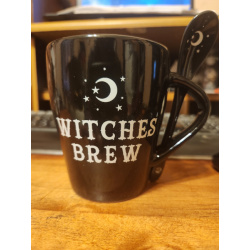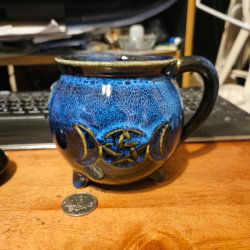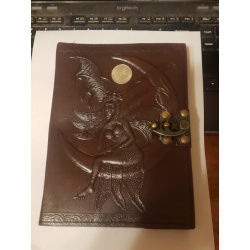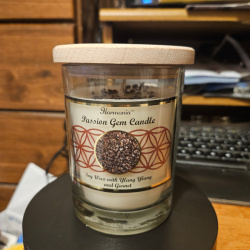Latest Products
-
 Witch's Brew Mug w/ Spoon
$13.00
Witch's Brew Mug w/ Spoon
$13.00 -
 Triple Moon Pentacle Mug
$20.00
Triple Moon Pentacle Mug
$20.00 -
 Moon Fairy Journal
$45.00
Moon Fairy Journal
$45.00 -
 Gem Soy Wax
$15.00
Gem Soy Wax
$15.00
Butterfly Pea Flowers - Clitoria ternatea
25g
$4.00
Butterfly-pea flower tea commonly known as Blue Tea is a caffeine-free herbal tea, or tisane, beverage made from a decoction or infusion of the flower petals or even whole flower of the Clitoria ternatea plant. Clitoria ternatea is also known as butterfly-pea, blue-pea, Aprajita, Cordofan pea, Blue Tea Flowers or Asian pigeonwings.
Derived from a plant that is common to most South East Asian countries butterfly pea flower tea has been brewed for centuries but only recently been introduced to tea drinkers outside the indigenous area. Butterfly pea flower tea gains its distinctive tint from the deep blue color of the petals that has made the plant a popular dye for centuries. One of the aspects of the tea is the fact that the liquid changes color based on the pH level of the substance added to it, for instance, adding lemon juice to the tea will turn it purple.
In Thailand and Vietnam the butterfly blue pea flower tea is commonly mixed with honey and lemon for a drink usually served after dinner, or a refreshment at hotels and spas, a preparation called nam dok anchan in Thai. The nam dok anchan drink has been described as being a typical local drink like chamomile tea is in other parts of the world. The tea is found in both hot and cold varieties, where the cold version is often mixed with honey, mint, cinnamon, passion fruit, and ginger
Medicinal:
The use of Butterfly Pea for its healing benefits dates back hundreds of years with origins in Ayurvedic medicine.
Throughout history, traditional healers in Southeast Asia and China would use the plant to help with occasional stress and insomnia.
Butterfly Pea Flowers contain potent antioxidants, which are known to protect against the damaging effects of free radicals. Antioxidants also help to slow down the aging process and protect against premature aging. They can boost the appearance and health of your skin, hair, and nails.
Butterfly Pea Flowers are also rich in anthocyanins, which further help to build and restore the skin’s collagen. Anthocyanins are water-soluble compounds that occur naturally in certain pigmented blue, red, purple, and black foods and flowers.
Finally, Butterfly Pea Flowers may possess significant anti-inflammatory and analgesic properties
Lore:
The legend pertaining to its origin which is not just fascinating but as mesmerizing as the flower itself. The story goes back a thousand years when much of East Asia was covered with Himapan forests which were believed to be home to a variety of mythical creatures. An idea of the types of creatures who inhabited the Himapan Forests could be gained by observing the statues that adorn the ancient temples of this region. Mystical in appearance, each is believed to be a hybrid of two or more animals owing to the forest area being positioned between heaven and earth, thus acting as a gateway on both sides. This was the reason as to why many inhabitants of the Himapan Forests had an ethereal quality but were equally sensitive to pain and suffering that is characteristic of earthly creatures.
Among these was a creature named Kinnari, a hybrid of a swan and a woman. Owing to her half-bird nature, Kinnari could fly across the skies and it was during one of her nocturnal flights that she observed a woman trying to sleep through deep distress. ‘Isra’ was her name and native to the land, it turned out that she was suffering from multiple ailments, all of which were not just having an adverse impact on her daily life but were also interfering with her sleep. Kinnari decided to help Isra by indicating her to follow and they both embarked on a flight that spanned mountains, lakes, temples, and several settlements before coming to an end at the edge of the famed Himapan Forest.
Kinnari led Isra along the path wherein several natural aromas graced their nostrils and they kept walking till Kinnari halted in front of a bush bearing blue flowers. It was a flower that Isra had never seen before and hence it appeared exotic and alien to her. But Kinnari not only seemed familiar with it but was also well aware of its numerous curative powers. She plucked a part of the plant and, handing it to Isra, instructed her to carry it back to her village. She specifically told Isra to sow the plant next to a fence so that it would get adequate support for climbing up and spreading in all directions.
Isra did as she was told and soon had a full-fledged creeper in her garden which bore plenty of flowers every day. Enticing as their blue color was, over a period of time, Isra realized their potential as natural medicines and began using them for her hair. It was serendipity that she brewed tea from them and having distributed it among her neighbors, she even experimented by squeezing a few drops of lime and watching it transform into a vivid purple.
- Availability: 37 In Stock





